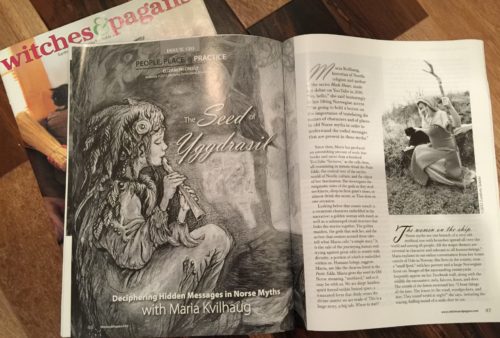FOREST GROVE, Ore. — Pagan magazine publishing might be considered a cottage industry, with a rich tradition that extends back to the days when newsletters were created on photocopy machines and shared ad infinitum among friends. BBI Media might not be operated out of an actual cottage, but it is one of the last remaining publishers of Pagan-focused print magazines in the United States, and it isn’t exactly an empire, either.

“We work out of our basement,” said Anne Newkirk Niven, whose company puts out both Witches & Pagans and SageWoman magazines. “People are surprised when they call and I answer the phone. It’s just my husband, my son, and me.” BBI Media has never been the sort of company that is headquartered in a gleaming tower with the CEO’s corner office providing a command view of the world below. It is more like a shining soapbox, a place where Pagans with something to say have been able to find an audience.
Through a number of magazine titles and a wide variety of blogs hosted at Pagansquare.com, Niven has provided opportunities for Pagan writers who may or may not be ready to publish an entire book. She offers an opportunity for thoughtful discourse in a world where reaction often outpaces cognition.
Niven is unable put a date on when she first identified as Pagan, but estimates that it’s been about thirty years. “I’m an eclectic polytheist Witch,” she said. “I do think that different gods have agency, but I have a great fondness for the God and Goddess.”
She considers the fact that her livelihood is based on serving the Pagan community a great boon. “I’m very, very lucky and fortunate,” she said. “I’m sure a lot of people would like to dedicate their professional life to Pagan practice. It’s a great blessing.”
![Anne Newkirk Niven [courtesy photo]](https://wildhunt.org/wp-content/uploads/2016/11/Anne-lake-photo-Beltane-2012.jpg)
Anne Newkirk Niven [courtesy photo]
“I had a copy of SageWoman, and cold-called the publisher,” she explained. The timing was right. The publisher “had just had one printed upside-down and backwards,” and was ready to try someone new. After successfully printing it right-side up for several issues, Niven learned that the publisher had “hit hard times.”
“I offered to buy the magazine with an inheritance from my mother,” Niven said. Three years after making that purchase, Niven took on editing responsibilities, as well, starting with issue 25. SageWoman now has 90 issues published, with Niven editing all those since.
“Don’t quit your day job,” Niven said, as a warning to anyone who wishes to follow in her footsteps. “You won’t draw a salary for a long, long time.”
Building upon SageWoman, a number of other titles have been created over the years: PanGaia, New Witch, Blessed Be, and Crone were all created as BBI periodicals. SageWoman and Witches & Pagans are the only two now being published by the company, and Niven said that there are no plans at this time to create any new titles.
What’s stayed the same through all the titles and all the years, Niven said, is the desire to “tell our stories to each other. Inspirational, relatively upbeat stories. That’s why we’re still around.”
Surviving as a magazine publisher alongside the internet is no small feat. Doing so while serving a Pagan community that is undergoing massive change adds another layer of challenge. “Paganism is more varied and complex” than when the first issue of SageWoman hit the stands, Niven said. “It was very Wicca-flavored, at least the West Coast Paganism I’m familiar with.”
She went on to describe a Paganism steeped in hippie counterculture, protests, and peace movements. It was in opposition to anything that had a whiff of “establishment” to it. “Now, we’re everywhere. Some are working on Wall Street, at least one is in the presidential administration, and there are Pagans in every profession. I even know several Christian ministers who are Pagan. It is no longer scary to say you are a Witch or Pagan,” she added, although acknowledging that the fear still exists in some areas.*
“In a sense, we’ve won,” Niven said, noting that she began this work in the heyday of Jack Chick, the Christian comic artist who died last month. “We no longer have to convince people that we aren’t going to sacrifice their children and cats; that’s no longer a mainstream belief about us. Mostly, we’re seen as harmless goofballs.”
As the number of Pagans has risen — Niven guessed that there are ten times as many as when she started on her path — being seen as “goofballs” is a “sea change” from when most people, as she said, “thought we were evil, or didn’t know we exist.”
She hopes that BBI publications has helped in some way.

While perceptions of Paganism among members of the general public have changed, so too have Pagans changed in how they view themselves. Recalling a time when nearly all Paganism was Wiccan influenced, Niven said, “In the ’90s, we thought it was the ‘old religion’ with an unbroken lineage. Metaphorically yes, but literally no. We now have more sophistication about our roots. That’s important, because it keeps fundamentalism down.”
A 1995 issue of PanGaia published a lengthy article debunking of the trope that nine million women were burned during the so-called “Burning Times.” Niven said that she is still quite proud of that piece. She did add that she likes the song that Charlie Murphy wrote about it, but said that “there are no winners in the victim Olympics.”
Awareness brings its own issues. Pagans, particularly Witches, are now a regular part of Hollywood entertainment. While that in part helps to normalize the idea of Paganism, there are consequences. “I get asked for spells like body-switching from time to time,” Niven said, not to mention requests for instant wealth. “I would have used that myself!” she said.
Today, Paganism has many branches that stem from Wicca, and many more that do not. Polytheists and Heathens do not always consider themselves Pagans, based on what they feel the overarching values associated with that label are. Niven thinks Paganism “resembles first-century Christianity,” in that there are many factions and a fair bit of theological squabbling.
“It’s very cool, and totally healthy,” she said.
Niven hasn’t been a member of an established group in quite some time, and in that way mirrors most of her readers. “I think about Paganism 60-70 hours a week,” she explained, “and at the end of the day, it’s time to have dinner, watch television or play a game.” Repeated surveys have shown her that most readers of BBI magazines also worship largely on their own.
“Back in the day, there was a theory that one became a Witch by saying so three times. Self-initiation is absolutely a thing. There’s no pope setting the rules.” In addition, most Pagans and others stuck with that label tend to bristle at the idea of hierarchy, she has observed.
In a sense, Niven thinks that the trend toward solitary practice is an historical aberration born of the current culture of individualism. “In a hundred years, or 200, it might transform again into set of more socially-controlled religions, and that probably wouldn’t be a bad thing.” Witches, however, will likely always have a solitary role to play, living on the edges of society and providing wisdom and healing to those who seek it.
Continuing to publish on paper also makes BBI Media stand out. “Paper is becoming a premium product,” Niven said, calling it an underrated technology that’s easy on the eyes and doesn’t require a power source. “Comparing paper and digital is like comparing cabbage and a banana,” she said, “they just don’t taste the same.”
Niven feels that paper is superior for long-form writing, and that’s what is mostly what is presented in her magazines. The bloggers at Pagansquare.com tend to write shorter pieces, which is suitable for that medium. Digital is much better for information such as phone numbers, where a search function makes the data more usable.

Niven believes that there will always be an audience for paper. “The ecological footprint of digital is not zero,” she said, and BBI publications have been printed with soy ink on recycled paper for far longer than most people knew about those options. There’s also a number of her readers that prefer to peruse the magazines while in the bath, which can be trickyr when using a tablet.
BBI became one of the last publisher of print Pagan magazines in North America last year, when Circle Magazine’s final issue was published. She attributes that not to any failing on the part of Circle’s staff, but to a difference in mission. “[Circle Magazine] was never their main ministry. Publishing is all we ever do. We don’t hold services, give degrees, consecrate, or initiate.”
What the hardworking people at BBI Media do instead is provide a platform for mostly positive pieces on Paganism, in all its many forms, including for people who don’t want to be called Pagan at all but would like to be heard by those who do.
[Author’s Note: This interview took place prior to the recent presidential election, and does not reflect any events that have occurred since that time.]
The Wild Hunt is not responsible for links to external content.
To join a conversation on this post:
Visit our The Wild Hunt subreddit! Point your favorite browser to https://www.reddit.com/r/The_Wild_Hunt_News/, then click “JOIN”. Make sure to click the bell, too, to be notified of new articles posted to our subreddit.
Whatever happened to The Green Man, a magazine for Pagan men in the 1990s? Not a big enough market?
It was merged into Pan Gaia which was eventually folded into New Witch to become Witches & Pagans. I was a Green Man reader too!
Thank you.
The Green Man was one of several titles with too small a niche; also in that category was The Blessed Bee (for Pagan families) and Crone (for women over 50.) A few back issues of The Green Man are still in print, along with all the Blessed Bees, and a few of the Crones. Thanks for asking!
Nice interview with one of our wise ones. Thank you for all you have given to our community over the years!
Anne has been a real gift to our community.
Anne is a treasure. Thanks Terrance.
I love the magazines. For solitaries, it’s a way for us to learn from other Pagans and share information with non-Pagans. I’ve downloaded several older issues, too. Thank you for this article!
Magazines are a great resource and connection to the entire Pagan spectrum for inmates. The inmate circle at San Quentin has a subscription, courtesy of Anne and BBI Media. For those who cannot get online, it’s a lifeline.
Anne is a simply amazing person. She is wise, funny, and very open. Our community is very lucky to have her and her family working for us. Here’s a link to an interview I did with her back in 2014:
https://www.youtube.com/watch?v=fEJTw_PmMAQ&t=941s
Thanks Anne!!